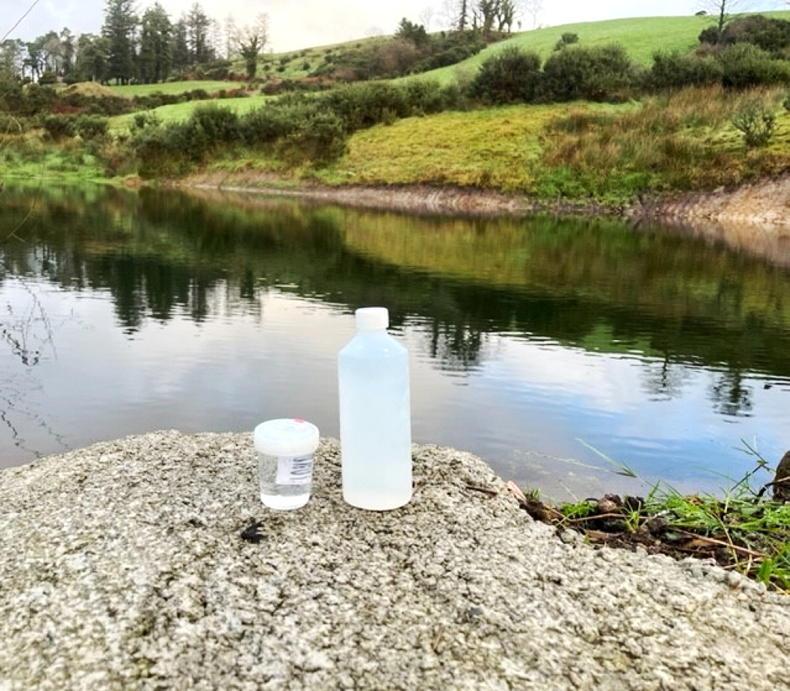Over the last number of months, we took water samples from various locations on the Footprint Farms and we sent these samples to the laboratory for analysis.
These water samples were taken to investigate the water quality status on the Footprint Farms to ensure the water is safe, free from environmental risks and to monitor into the future.
It is important that farmers know the quality status of the water on their farm and how certain farming practices could negatively affect water quality if the necessary care and precautions are not taken into consideration.
Teagasc has reported and identified agriculture as one of the largest pressures on water quality in Ireland, so for this reason samples were taken to ensure our Footprint Farms have adequate water quality. To date we have taken 17 water samples across the Footprint Farms and will be taking more throughout the duration of the Footprint Farmers Programme.
Sampling procedure
Each water sample was collected and tested for pH, conductivity, iron, manganese, aluminium, total hardness, total coliforms, E coli, colour, turbidity, ammonium, nitrate, nitrite and sulphate levels.
On each farm a sample was taken from the main water source used for the farm which was either a private well or a water scheme. Other water samples were taken from ponds, drains and streams on specific farms and these sampling points were identified by each farmer as a potential pressure on their water quality on the farm.
So far on the Footprint Farms, water results are varied. It is important to note all water testing is conducted in accordance with SI 122 of 2014 Drinking Water Regulations standards.
When we examined the results closely, there were 12 out of 14 parameters evaluated within the optimal range. This is good news for our Footprint Farmers, particularly because water in drains was meeting drinking water quality standard in most cases.
These 12 parameters included pH, conductivity, iron, manganese, aluminium, total hardness, colour, turbidity, ammonium, nitrate, nitrite and sulphate.
On a small number of samples where results exceeded drinking water allowances it was in farm drains and samples were above limits for E coli and coliforms. However, not to a concerning level and not where animals are drinking. The cause of this could be an animal upstream.
It is also important to note that these results only capture a snapshot in time. In water quality projects samples are analysed regularly throughout the day.
What do these water results mean for our Footprint Farmers?
For most of our Footprint Farmers, overall water quality is good. However, ongoing care and attention is necessary to ensure water sources are protected. For the Footprint Farmers with higher total coliforms and E coli levels, there have been a number of counteractive and preventative measures implemented at farm level.
For example, one of the Footprint Farmers has increased their buffer zone in the paddocks that run along this drain and ensured fencing is adequate to prevent livestock from gaining access to this farm drain.
Another example is where a Footprint Farmer improved the hedge along the main drain on their farm by planting Holly plants to ensure the hedge will be stock proof. This will ensure the water source is protected from livestock on their farm.
The effects
Some of our Footprint Farmers never had their water analysed before, so they were keen to get their results. The water sample results highlighted to our Footprint Farmers the importance of paying attention to water quality on an ongoing basis and have identified a number of farming activities that can put pressure on water quality. These farming activities include organic and chemical fertiliser application, farmyard manure storage, livestock housing, and waste water collection.
How Footprint Farmers dealt with results
A renewed focus on water quality has been established among the Footprint Farmers after testing the initial water samples. For some of our Footprint Farmers water samples were optimal as outlined previously but these farmers understand how easily this can change and will closely monitor farming activity.
Improvements have been and can be made at farm level, including a more targeted approach when using slurry and chemical fertiliser, improved farmyard manure storage and waste water collection facilities in the farmyard. These water samples were of benefit to the Footprint Farmers as they highlight the good work being done and where improvements can be made to ensure water quality is kept to the highest standard on our Footprint Farms.






 This is a subscriber-only article
This is a subscriber-only article











SHARING OPTIONS: